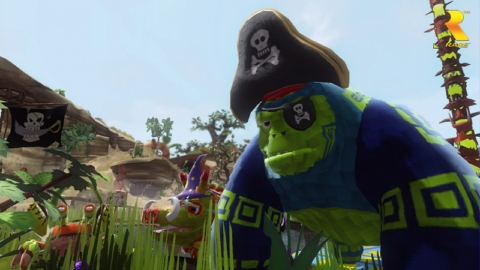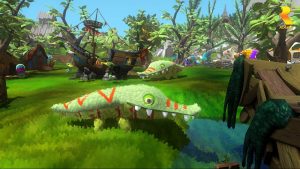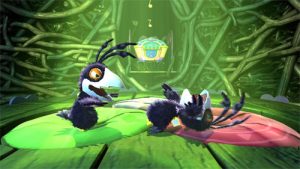Viva Pinata: Trouble in Paradise Review – Is it Worth Playing Now?

Released in 2008 for the Xbox 360, Trouble in Paradise (TiP) is the sequel to 2006’s Viva Pinata. I have opted to review the sequel as it very much builds on everything the first game does without being too different – in that it’s almost an expansion of the first game. The majority of the game’s positives and negatives apply to both games, so I’d recommend playing TiP if you’ve never played either game.
Brief summary: The player takes control of a garden which they can design, expand and fill with whatever they please. The main aim of the game is to attract pinatas (lovable cartoon animals) to your garden and persuading them to take up residence. You can do all kinds of things with them including building them homes, breeding them, selling them, and dressing them up in little hats.

The gorgeous aesthetic of the game is its biggest achievement, with the vibrant colours and excellent animations painting a wonderful picture.
The Good
+ Joy of discovery: The best thing about the game is the feeling you get when a new pinata approaches the garden, and you succeed in making it a resident. The rarer animals can have particularly stringent requirements (80% of your garden is filled with water, have 6 fully grown banana trees, etc) and the cut scene of an animal becoming a resident is a satisfying reward for your painstaking garden craftmanship.
+ Lots of animals: There are over 80 animals in the game, wich doesn’t include the various colour variants and evolutions. Each animal is unique and has its own preferences, personalities and characteristics, which represents real value. Many animals are also un-co-habitable – either fighting whenever they meet, or requiring conflicting environments – forcing the player to think carefully about how they lay out and divide their garden. In order to habitate all of the pinatas in the game, you’ll need more than one garden.
+ Lots of other things: Rare haven’t restricted the attention to detail to the pinata. There’s an impressive amount of depth to the other features of the game – the plants and trees all have to be treated well to get the most out of them, and planted in different types of soil or given different plant food, will yield different results. The other NPCs in the world are also charming and add another layer to the game – with each of them providing a service to the player to help them improve and maintain their garden.
+ Technical treat: As the gameplay is quite passive, the aesthetics of the game have the tough job of retaining your attention but also being easy-on-the-eye. The game is a delight to look at, with vibrant colours of the pinata meshing with the environment beautifully. The bloom lighting is used well, and the animation of the pinata has clearly had a lot of love and care applied, with almost Ardman-esque levels of attention to detail.

The constant threat of the Ruffians can get annoying but does serve to keep you on your toes.
Neither Good nor Bad
~Difficulty: Don’t let the sickly sweet style fool you – this game is a challenge. once your garden grows, so does the risk of potential pitfalls and number of things to micro-manage and juggle. It can turn into quite a daunting task remembering to water your plants at the right time whilst trying to lure in that Chippopotamus you’ve been trying to nab for the past two hours, and younger gamers may get frustrated with the amount of time it actually takes to make progress.
~Trouble: As suggested by the title, the theme of the game is ‘trouble’ – with threats to your garden that were present in the original given more prominence in TiP. Professor Pester and the Ruffians will be a constant thorn in your side, coming into your garden and annoying your pinata – as if you didn’t have enough trouble managing your garden as it is. Whilst it does add another layer of depth to the game, it does get frustrating and I often found myself wondering if I would enjoy the game more without the constant threat of a nuisance.
~Wild zones: Another promoted feature of TiP was the addition of two ne ‘wild areas’ – Pinarctic and Dessert Desert – which allow the player to capture wild Pinata and bring them back to their garden. These areas are fine, but they didn’t really add anything to the game, as the capture process is quite laborious, and doesn’t compare to the satisfaction of luring a pinata into your garden the traditional way.

The mating mini-games offer a fun diversion from the regular gameplay.
The Bad
-Controls: The main controls haven’t really evolved since the first game. It’s never easy to employ a cursor-based UI on a console, and whilst TiP does an OK job, you can’t shake the feeling that they could be done better.
-Size limitations: The garden size has been increased over the original, but it is still far too small, and worse still the game deems your garden to be ‘full’ at a certain point, stopping you adding more things. This is probably due to technical limitations of the 360, but understandable as it may be, it’s still a frustration.
-Autosave judder: An unfortunate hangover form the last game is the ‘judder’ the game experiences when it auto-saves, often causing you to mess up what you’re doing at the time. It was a well documented criticism of the first game, so it’s a shame it wasn’t improved upon for the second.
Overall
Viva Pinata: Trouble in Paradise is a unique game that certainly isn’t for everyone, but at its best can elicit a sweet sense of calm satisfaction not found in most other games.
8/10